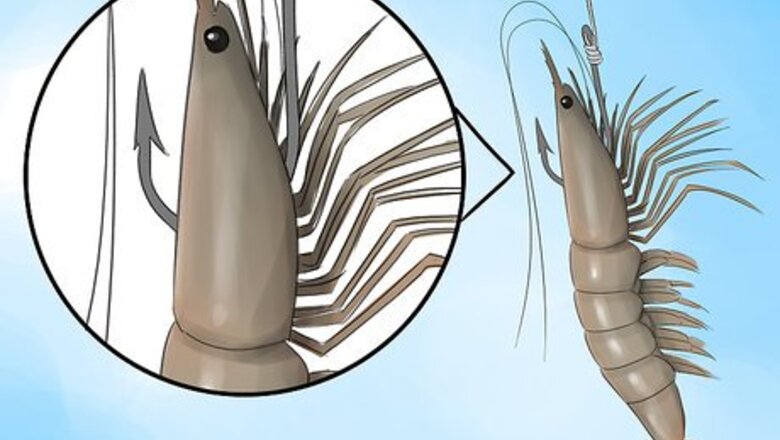
views
Methods for Rigging Live Shrimp
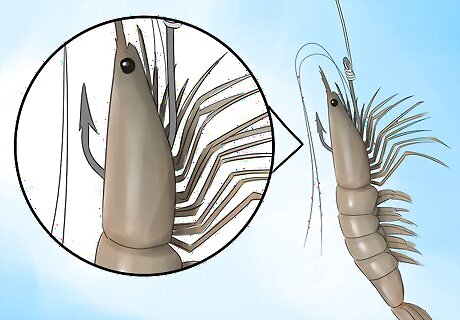
Hook the shrimp through the head when casting or trolling. Many fishermen like to hook their shrimp through the head. There are two ways to do this. Insert the hook from under the shrimp’s head, and push the barb out on top, avoiding the vital organs. This method is preferred when fishing the bait off the bottom.Hook a Shrimp Step 1Bullet1.jpg Insert the hook through the top of the shrimp’s head, working the point under the vital organs before pushing it out elsewhere on the top of the head. This method is preferred for bottom fishing.Hook a Shrimp Step 1Bullet2.jpg There is one drawback to hooking a shrimp through the head: it is more likely to fall off the hook.Hook a Shrimp Step 1Bullet3.jpg

Hook the shrimp crosswise through its carapace for drift fishing or float-rigging. Poke the hook through just under the shell tip, avoiding the stomach and pancreas. (These appear as dark spots on the shrimp’s body.) This takes advantage of the shrimp’s swimming action. You can also hook the shrimp just below its head and thread the shrimp so that the hook comes out in the center of the carapace between its vital organs. This lets you cast further and retrieve the shrimp more easily, but it will die sooner than if hooked crosswise through the carapace.Hook a Shrimp Step 2Bullet1.jpg
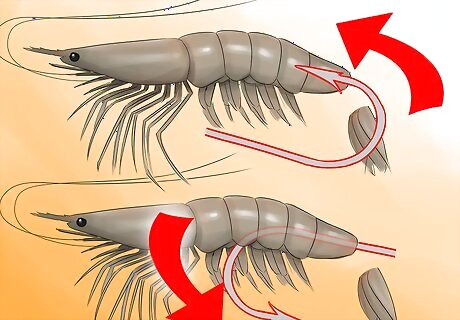
Hook the shrimp through the tail when casting for cruising fish. This method lets you cast still further, as the shrimp’s head, where most of its weight is, will propel the bait further without tearing the shrimp’s body off the hook. Break off the shrimp’s tail fan, then thread the hook through the tail center to hide it and poke it out through the underside of the tail, far enough for the shrimp body to cover the hook eye. You may want to use a baitholder hook, one with barbs on its shank, to better hold the shrimp’s tail in place.Hook a Shrimp Step 3Bullet1.jpg Breaking off the shrimp’s tail fan releases a fish-attracting scent.Hook a Shrimp Step 3Bullet2.jpg You can also hook the shrimp crosswise through the tip of its tail. This method is preferred when dealing when heavy bottom snags other than weeds.Hook a Shrimp Step 3Bullet3.jpg

Bury the hook in the shrimp’s body when fishing in a lot of weeds. This method of rigging a shrimp is similar to the self-weedless rigging that bass fishermen use when fishing plastic worms. Break off the tail fan, then run the point completely through the tip of the tail. Pull out the shank and rotate the hook so its point faces the shrimp’s underside, and then bury the point in the meaty part of the tail. This self-weedless arrangement can be fished on a Carolina rig. Thread a 1/4 ounce (7.09 g) sliding sinker onto your line, then tie on a swivel. On the other end, tie 6 to 12 inches (15 to 30 cm) of leader and your hook, then bait it with a shrimp. The weight will take your baited hook to the bottom, while the swivel will keep it from sliding all the way to the hook, and the leader will let your bait rise just off the bottom. You can also use this arrangement with a 3-way swivel. Attach your line to one end of the swivel, your bait and leader to a second end, and a 1/4 to 2 ounce (7.09 to 56.7 g) bell or dipsey sinker to the third end.
Methods for Rigging Dead or Frozen Shrimp
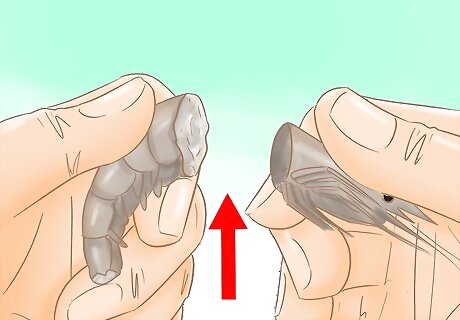
Dismember the body. While live shrimp entice fish to strike by how well they swim, dead shrimp draw fish by how they smell. For that reason, you can break off the head, feet, and tail fan before threading the rest of the body on the hook – and some anglers don’t even bother to take this step.
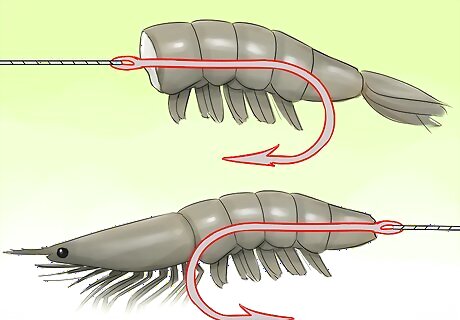
Thread from the head end or the tail end. Either method is valid; you just have to make sure the entire shank of the hook is covered.
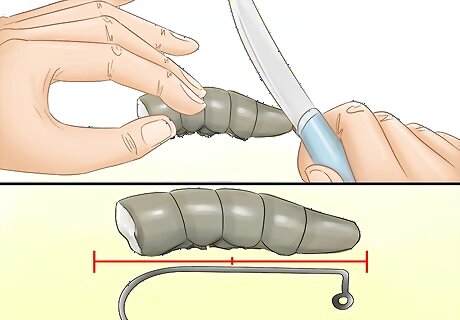
Sweeten your jig with dead shrimp. Dead shrimp are great for adding the test of real crustacean to a jig, whether it has a skirt or a soft plastic body. If you decide to tip your jig, cut the shrimp with a knife into hook-shank-length pieces. This will ensure the bait is the right length and, by cutting instead of breaking, keep the flesh firmer and on the hook longer. For particularly meaty pieces of dead shrimp, you may want to add a trailer hook to ensure that the fish don’t take the bait and miss getting hooked. Some anglers prefer to pinch off the tail fan and joint above it, then thread the shrimp tail-first onto the jig head, making sure the shrimp body lies flat when the hook is pushed through the body.
Keeping Live Shrimp
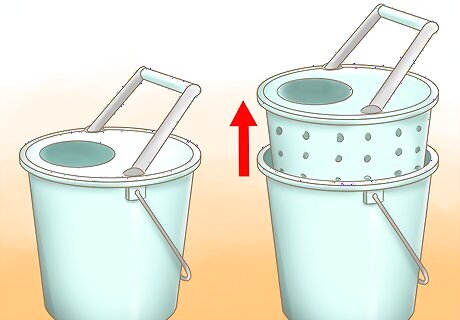
Choose your bucket wisely. You can keep live shrimp in either a single-layer bucket or a two-layer minnow bucket. A two-layer minnow bucket makes it easier to change the water as needed. Some guides use 5 to 15-gallon (18.9 to 56.8 l) buckets.
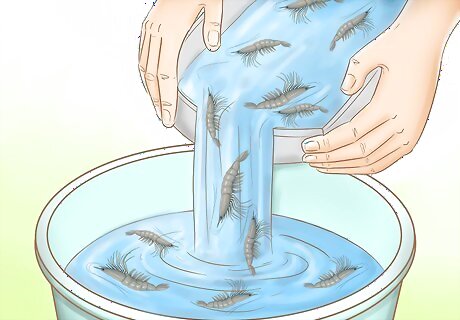
Know what your bucket can hold – and don’t overfill it. Too many shrimp in the water means some of them will start to die – and when some die, others will soon follow.
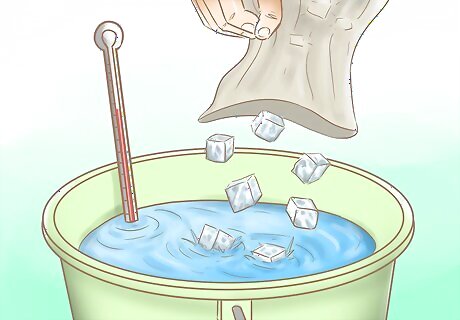
Keep the water cool. Check the temperature regularly, and add ice as needed to maintain it. Change the water every so often to keep the shrimp in cool and clean water.

Oxygenate. Like any other marine creature, shrimp need a supply of oxygen to stay alive. There are two ways you can supply it: Use an aerator.Hook a Shrimp Step 11Bullet1.jpg Use an oxygen-releasing tablet. Both of these items are available for use with minnow buckets and will work just as well with shrimp.Hook a Shrimp Step 11Bullet2.jpg
Keeping Dead and Frozen Shrimp
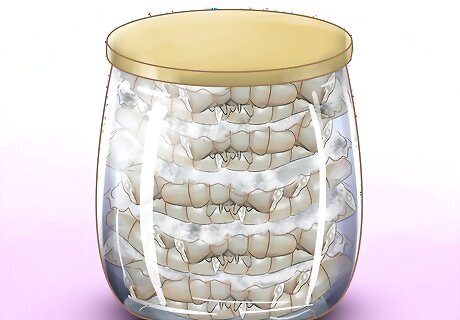
Preserve dead shrimp like pork rind. Dead shrimp can be preserved in brine and carried in small jars the way freshwater fishermen carry pork rind in their tackle boxes. You follow this procedure: Get 1/2 to 1 pound (226.8 to 453.6 g) of fresh shrimp.Hook a Shrimp Step 12Bullet1.jpg Remove the shells, heads, and tails.Hook a Shrimp Step 12Bullet2.jpg Cut them into pieces twice the size at which you’d fish them live. Place a layer of salt in the bottom of a small jar.Hook a Shrimp Step 12Bullet4.jpg Place a piece of cut shrimp on top of the salt.Hook a Shrimp Step 12Bullet5.jpg Place a layer of salt on top of the cut shrimp. Place another piece of cut shrimp on top of the salted shrimp. Repeat alternating between salt and shrimp layers until the jar is full. The salt will preserve and toughen the shrimp to make it stay on the hook longer.
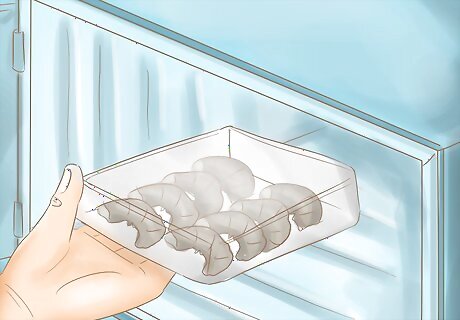
Refreeze unused frozen shrimp. Unused frozen shrimp can be packaged and re-frozen for use on another fishing outing, as long as they haven’t spoiled. It’s best to check with your significant other about doing so and to carefully separate the packages of frozen shrimp from frozen foodstuffs and label them as frozen bait shrimp.

















Comments
0 comment